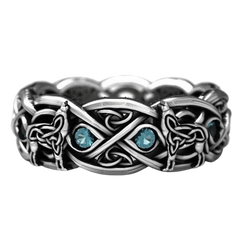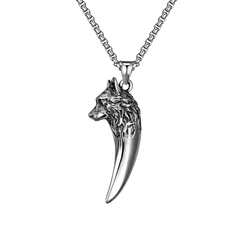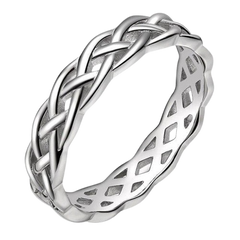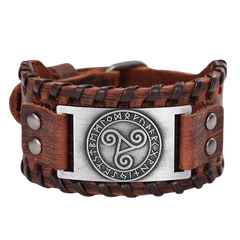How the Celtic Cross Became a Symbol of Power, Protection and Spirituality
- min of reading
Summary :

Nordic Wolf Celtic Ring
£25.70

Wolf Head Necklace
£25.70

Celtic Entwined Ring
£29.18

Celtic Triskel Bracelet
£25.70

Viking Rune Ring
£29.18
Discover the fascinating history and evolution of the Celtic shamrock symbol
The Celtic cross , originating from ancient Celtic tradition, has gradually become a symbolic emblem of Celtic identity and culture . Its origins date back to a distant era, when it was initially used to mark graves, thus ensuring a tangible link between the deceased and their spiritual heritage. However, over time, the Celtic cross has transcended its primary function as a funerary monument to become a deeper and more versatile representation of Celtic spirituality.
It has evolved beyond its original meaning, embracing a unique symbiosis between Christian beliefs and pagan traditions, establishing a spiritual connection between the earthly world and the divine. This symbol, imbued with spirituality and protection, has acquired an importance far beyond cemeteries, becoming a true cultural emblem and a reflection of Celtic identity, carrying a rich and complex history that has endured through the centuries.
The Celtic Cross: A Bridge Between Two Worlds
The uniqueness of the Celtic cross lies in its distinctive design, seamlessly merging a Christian cross with a circle. This symbolic union embodies the convergence of Christian spirituality and Celtic pagan beliefs, creating a symbol rich with profound meaning. The cross , emblematic of Christianity, is enveloped in a circle, adding an extra dimension to its essence. This circle represents infinity, eternity, and creates a connection between the divine and the human. Thus, the Celtic cross becomes much more than just an object of faith; it emerges as a powerful symbol, offering protection from evil forces while serving as a channel for a deep spiritual connection with the divine. It is in this unique fusion that the Celtic cross reveals its versatility as a tangible representation of a complex and balanced spirituality between two worlds.
- 316L stainless steel
- water resistant
- snake mesh chain
A Symbol of Identity and Pride
Throughout the ages, the Celtic cross has captured the admiration of many devotees and has become a symbol of pride and identity within Celtic communities across the globe. Its appeal transcends borders and generations, enduring as a powerful emblem that embodies the spiritual and cultural heritage of the Celts . Today, this remarkable emblem continues to adorn a variety of artistic forms, from jewelry to tattoos to artwork. The Celtic cross is thus much more than just a historical symbol; it remains a living and dynamic expression of Celtic cultural richness, carrying with it a timeless meaning that continues to inspire and unite individuals around the world.
Delve into the history and deeper meaning of the Celtic cross
Let us now delve into the history and deeper meaning of the Celtic cross to reveal how it continues to exert a significant influence on Celtic spirituality and culture . Over the centuries, this cultural imprint has evolved and adapted, while maintaining its symbolic power. Understanding the genesis of the Celtic cross and the layers of meaning attached to it allows us to fully grasp its impact on the daily lives of Celts past and present. By exploring its historical roots and unveiling the layers of symbolism that compose it, we reveal a window into the depth and complexity of Celtic spirituality, while highlighting how this cross continues to transcend time, remaining a source of inspiration and connection with the cultural foundations of this community.

Historical origins of the Celtic cross
The roots of the Celtic cross go deep into the ancient history of Celtic culture, going back several millennia. The first manifestations of this sacred symbol date back to the Iron Age, a time when it was initially used to mark the graves of the deceased. Within this Celtic civilization, the cross had a much deeper character than simply marking a grave. It was seen as an instrument of protection, intended to watch over the soul of the deceased and facilitate their passage to the afterlife.
The importance attributed to the Celtic cross at this time is a testament to the Celts' deep connection with the spiritual and their belief in the existence of an afterlife. Considered a bridge between the world of the living and the spirit world, the Celtic cross symbolized not only respect for the deceased but also the belief in spiritual protection, ensuring a peaceful transition to the afterlife. These fundamental historical roots contribute to enriching the significance of the Celtic cross as a symbol charged with deep spirituality and ancestral funerary rituals.
Symbolism of the Celtic Cross
The Celtic cross emerges as a symbol of profound richness of meaning. Its form, a cross associated with a circle at the top, encapsulates the harmonious union of the divine and the human, the spiritual and the material. Each element of this symbol has a particular meaning, contributing to its symbolic power .
The circle at the top of the Celtic cross embodies the notions of infinity and eternity. It represents a timeless connection to the divine, transcending temporal boundaries and offering an infinite perspective on spirituality. The arms of the cross, on the other hand, are not simply extensions, but carry a deeper meaning. They represent the four fundamental elements of nature – earth, air, fire and water. This comprehensive representation underscores the Celtic cross’s anchoring in the natural and elemental forces that govern the cosmos, demonstrating a holistic connection with the environment around us.
Thus, the Celtic cross stands as a true symbolic bridge, transcending dualities and unifying the spiritual and material dimensions of existence. Every aspect of its complex form invites reflection, creating a symphony of meanings that elevates this symbol beyond its visual aspect, making it a powerful and holistic representation of the Celtic worldview.
Power and authority associated with the Celtic cross
Delve into the exploration of the notions of power and authority that are intrinsic to the Celtic cross, and discover how this symbol transcends its traditional role as a simple decoration. Far from being a purely visual ornament, the Celtic cross imposes itself as a bearer of symbolic power, evoking profound concepts that resonate beyond its external appearance.
The Celtic cross embodies a spiritual authority , uniting the divine and the earthly, and thus holds a symbolic power that goes far beyond its physical representation. It bears witness to an intimate connection with mystical forces and the cycles of life, imbuing those who wear or venerate it with a sense of spiritual authority and deep understanding of the fundamental aspects of existence.
This exploration of the dimensions of power and authority associated with the Celtic cross helps to unveil the complexity of this symbol, demonstrating that it goes far beyond a simple aesthetic . It offers a window into the spiritual influence it exerts, making each representation of the Celtic cross a declaration of connection with higher forces and an affirmation of the spiritual authority that results from it.
The protective qualities of the Celtic cross
Explore the fascinating history of the Celtic Cross and how it has forged its distinct reputation as a protective symbol, warding off negative energies and ensuring the spiritual safety of those who wear it. At the heart of this reputation is the deeply held belief in the Celtic Cross’s ability to act as a spiritual shield, protecting its wearer from harmful influences and ensuring a psychic safe haven.
The Celtic Cross, with its unique blend of Christian cross and pagan circle, is considered a sacred barrier against dark and evil energies. Its history reveals centuries of folk belief in its ability to ward off evil and provide unwavering spiritual protection. Whether through rituals, amulets, or simply worn as a talisman, the Celtic Cross has been revered for its ability to ward off evil forces, creating a sacred space around those who wear it.
This exploration of the Celtic Cross' protective reputation reveals a depth of spiritual intent and trust in its power to safeguard. By uncovering the mechanisms underlying this perception, we enter a world where the symbolic transcends the tangible, and the Celtic Cross stands as a bulwark of protection in the spiritual realm.
Spiritual Meaning of the Celtic Cross
Delve into the spiritual meaning of the Celtic cross , an exploration that reveals how this symbol transcends its visual aspect to embody fundamental concepts such as death, rebirth, and the cycles of life. The Celtic cross, with its unique shape combining the Christian cross with the pagan circle, becomes a portal to a deeper understanding of the cyclical nature of existence.
At the heart of its spiritual meaning is the representation of death and rebirth, symbolized by the arms of the cross. These arms evoke the concept of ending and beginning, emphasizing that life is an uninterrupted continuum, characterized by incessant cycles. The circle at the top of the cross reinforces this idea, symbolizing infinity and eternity, suggesting that life is a perpetual experience of renewal and transformation.
Exploring the spiritual meaning of the Celtic cross reveals how this symbol becomes much more than just an artistic representation. It becomes a visual expression of deep Celtic wisdom, reminding observers that life is a journey where death is but a step, followed by perpetual rebirth. In this way, the Celtic cross serves as a spiritual guide, inviting us to reflect on the natural cycles of life and find a deeper connection with the mystery of existence.

Cultural and Religious Uses of the Celtic Cross
Explore the diverse cultural and religious uses of the Celtic cross, a symbol that goes far beyond simply marking graves. Discover how the cross has become deeply intertwined with cultural and religious practices, participating in symbolic rituals and ceremonies of crucial importance over time.
Originally, the Celtic cross was closely associated with grave marking, embodying spiritual protection for the deceased and facilitating their transition to the afterlife. However, its use has extended far beyond this initial function. It has found its place in a multitude of symbolic rituals , where each arm of the cross, representing the four natural elements, becomes a path of connection with the forces of nature.
The important ceremonies of Celtic culture also welcomed the Celtic cross as a key participant. It became a significant presence at weddings, funerals, and other sacred rites, symbolizing spiritual connection and continuity across generations. This exploration of the Celtic cross’s diverse uses reveals how it evolved to become a central player in the cultural and religious fabric of the Celts, transcending its original role to become a versatile icon, carrying profound meanings in different ritual contexts.
Modern interpretations and adaptations of the Celtic cross
Discover the fascinating evolution of the Celtic Cross over time, a transformation that sees it adapt to modern needs and interpretations while preserving its spiritual essence. Over the centuries, the Celtic Cross has undergone a significant metamorphosis, integrating into contemporary contexts while retaining its deep spiritual meaning.
Adopted by different cultures and communities around the world, the Celtic cross has found new ways of expression. From contemporary artists to followers of modern Celtic spirituality, each has brought their own interpretation to this symbol, incorporating innovative elements while respecting its traditional roots. This adaptation has allowed the Celtic cross to remain relevant in the modern world, while continuing to embody the core values of Celtic culture .
Modern technologies, such as tattoos, sophisticated jewelry , and digital art representations, have also contributed to the contemporary renaissance of the Celtic cross. Its iconic look and deep spiritual connotations make it a popular choice for those looking to incorporate cultural and spiritual elements into their daily lives.
Thus, the story of the Celtic cross extends far beyond its ancient past, morphing to meet the needs of a modern age while remaining a timeless symbol. It is a story of adaptability, persistence, and continued resonance in the hearts of those who seek to find a balance between tradition and contemporaneity.
Controversies and Misconceptions About the Celtic Cross
Delve into exploring the controversies surrounding the Celtic cross and dispel the misconceptions often associated with this symbol rich in history and meaning. Despite its cultural and spiritual depth , the Celtic cross has sometimes been subject to misinterpretations and controversies that have overshadowed its true connotations.
One of the major controversies lies in the appropriation and use of the Celtic cross by groups for political or racist purposes. Although its origins date back millennia in Celtic culture, modern movements have sometimes diverted this symbol for purposes that contradict its original meanings. It is essential to demystify these appropriations and to recall that the Celtic cross, in its authentic context, embodies values of spiritual connection and respect for nature.
Additionally, misunderstandings persist about the true meaning of the Celtic cross, often exacerbated by cultural stereotypes or inaccurate media portrayals. By exploring these controversies, we can better understand how the Celtic cross can be misinterpreted and clarify its true nature as a cultural and spiritual symbol .
It is through this critical exploration of the controversies surrounding the Celtic Cross that we can dispel the misconceptions sometimes associated with it, thereby restoring understanding of its deep-rooted heritage and authentic meaning .
Conclusion: The Enduring Legacy of the Celtic Cross
In conclusion, let us dive together into the enduring legacy of the Celtic cross and understand how this symbol continues to transcend time, leaving an indelible mark on Celtic spirituality and culture. The Celtic cross, woven into the very fabric of Celtic history , is much more than just an artistic or religious symbol. It is a living narrative that has evolved over millennia, while maintaining its symbolic depth and power to captivate minds.
Its legacy is rooted in Iron Age burial rituals, spanning the ages where it has witnessed the evolution of cultural beliefs and practices. Today, the Celtic cross embodies a bridge between the past and the present, a constant reminder of Celtic wisdom that persists in our modern world.
As we explore its deeper meanings, we realize that the Celtic cross goes beyond its original role as a grave marker. It has become a source of inspiration, spiritual connection, and cultural pride for Celtic communities around the world. From jewelry to contemporary artwork, it continues to be a way to express Celtic identity and maintain an intimate connection with cultural roots.
Thus, the legacy of the Celtic Cross is not frozen in time, but rather a continuous thread that weaves Celtic spirituality and culture through time. It is an invitation to contemplate the depth of its meaning, to honor its past, and to recognize its enduring role as the keeper of the mysteries and traditions that have shaped the spiritual richness of the Celts. By embracing this legacy, we preserve a window into a time when the sacred and the natural came together harmoniously, inviting us to perpetuate this unique connection between the seen and the unseen.



































